Hanwen Du
Planning with Diffusion Models for Target-Oriented Dialogue Systems
Apr 23, 2025Abstract:Target-Oriented Dialogue (TOD) remains a significant challenge in the LLM era, where strategic dialogue planning is crucial for directing conversations toward specific targets. However, existing dialogue planning methods generate dialogue plans in a step-by-step sequential manner, and may suffer from compounding errors and myopic actions. To address these limitations, we introduce a novel dialogue planning framework, DiffTOD, which leverages diffusion models to enable non-sequential dialogue planning. DiffTOD formulates dialogue planning as a trajectory generation problem with conditional guidance, and leverages a diffusion language model to estimate the likelihood of the dialogue trajectory. To optimize the dialogue action strategies, DiffTOD introduces three tailored guidance mechanisms for different target types, offering flexible guidance towards diverse TOD targets at test time. Extensive experiments across three diverse TOD settings show that DiffTOD can effectively perform non-myopic lookahead exploration and optimize action strategies over a long horizon through non-sequential dialogue planning, and demonstrates strong flexibility across complex and diverse dialogue scenarios. Our code and data are accessible through https://anonymous.4open.science/r/DiffTOD.
Teach Me How to Denoise: A Universal Framework for Denoising Multi-modal Recommender Systems via Guided Calibration
Apr 19, 2025Abstract:The surge in multimedia content has led to the development of Multi-Modal Recommender Systems (MMRecs), which use diverse modalities such as text, images, videos, and audio for more personalized recommendations. However, MMRecs struggle with noisy data caused by misalignment among modal content and the gap between modal semantics and recommendation semantics. Traditional denoising methods are inadequate due to the complexity of multi-modal data. To address this, we propose a universal guided in-sync distillation denoising framework for multi-modal recommendation (GUIDER), designed to improve MMRecs by denoising user feedback. Specifically, GUIDER uses a re-calibration strategy to identify clean and noisy interactions from modal content. It incorporates a Denoising Bayesian Personalized Ranking (DBPR) loss function to handle implicit user feedback. Finally, it applies a denoising knowledge distillation objective based on Optimal Transport distance to guide the alignment from modality representations to recommendation semantics. GUIDER can be seamlessly integrated into existing MMRecs methods as a plug-and-play solution. Experimental results on four public datasets demonstrate its effectiveness and generalizability. Our source code is available at https://github.com/Neon-Jing/Guider
Video-Bench: Human-Aligned Video Generation Benchmark
Apr 07, 2025Abstract:Video generation assessment is essential for ensuring that generative models produce visually realistic, high-quality videos while aligning with human expectations. Current video generation benchmarks fall into two main categories: traditional benchmarks, which use metrics and embeddings to evaluate generated video quality across multiple dimensions but often lack alignment with human judgments; and large language model (LLM)-based benchmarks, though capable of human-like reasoning, are constrained by a limited understanding of video quality metrics and cross-modal consistency. To address these challenges and establish a benchmark that better aligns with human preferences, this paper introduces Video-Bench, a comprehensive benchmark featuring a rich prompt suite and extensive evaluation dimensions. This benchmark represents the first attempt to systematically leverage MLLMs across all dimensions relevant to video generation assessment in generative models. By incorporating few-shot scoring and chain-of-query techniques, Video-Bench provides a structured, scalable approach to generated video evaluation. Experiments on advanced models including Sora demonstrate that Video-Bench achieves superior alignment with human preferences across all dimensions. Moreover, in instances where our framework's assessments diverge from human evaluations, it consistently offers more objective and accurate insights, suggesting an even greater potential advantage over traditional human judgment.
Uncertainty-aware Knowledge Tracing
Jan 09, 2025Abstract:Knowledge Tracing (KT) is crucial in education assessment, which focuses on depicting students' learning states and assessing students' mastery of subjects. With the rise of modern online learning platforms, particularly massive open online courses (MOOCs), an abundance of interaction data has greatly advanced the development of the KT technology. Previous research commonly adopts deterministic representation to capture students' knowledge states, which neglects the uncertainty during student interactions and thus fails to model the true knowledge state in learning process. In light of this, we propose an Uncertainty-Aware Knowledge Tracing model (UKT) which employs stochastic distribution embeddings to represent the uncertainty in student interactions, with a Wasserstein self-attention mechanism designed to capture the transition of state distribution in student learning behaviors. Additionally, we introduce the aleatory uncertainty-aware contrastive learning loss, which strengthens the model's robustness towards different types of uncertainties. Extensive experiments on six real-world datasets demonstrate that UKT not only significantly surpasses existing deep learning-based models in KT prediction, but also shows unique advantages in handling the uncertainty of student interactions.
Captions Speak Louder than Images (CASLIE): Generalizing Foundation Models for E-commerce from High-quality Multimodal Instruction Data
Oct 22, 2024



Abstract:Leveraging multimodal data to drive breakthroughs in e-commerce applications through Multimodal Foundation Models (MFMs) is gaining increasing attention from the research community. However, there are significant challenges that hinder the optimal use of multimodal e-commerce data by foundation models: (1) the scarcity of large-scale, high-quality multimodal benchmark datasets; and (2) the lack of effective multimodal information integration methods. To address these challenges, in this paper, we introduce MMECInstruct, the first-ever, large-scale, and high-quality multimodal instruction dataset for e-commerce. We also develop CASLIE, a simple, lightweight, yet effective framework for integrating multimodal information for e-commerce. Leveraging MMECInstruct, we fine-tune a series of e-commerce MFMs within CASLIE, denoted as CASLIE models. Our comprehensive evaluation demonstrates that CASLIE models substantially outperform 5 categories of advanced baseline models in the in-domain evaluation. Moreover, CASLIE models show strong generalizability to out-of-domain settings. MMECInstruct and CASLIE models are publicly accessible through https://ninglab.github.io/CASLIE/.
SAPIENT: Mastering Multi-turn Conversational Recommendation with Strategic Planning and Monte Carlo Tree Search
Oct 12, 2024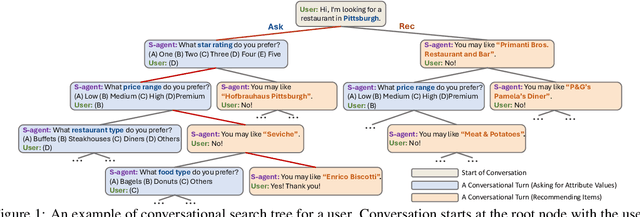



Abstract:Conversational Recommender Systems (CRS) proactively engage users in interactive dialogues to elicit user preferences and provide personalized recommendations. Existing methods train Reinforcement Learning (RL)-based agent with greedy action selection or sampling strategy, and may suffer from suboptimal conversational planning. To address this, we present a novel Monte Carlo Tree Search (MCTS)-based CRS framework SAPIENT. SAPIENT consists of a conversational agent (S-agent) and a conversational planner (S-planner). S-planner builds a conversational search tree with MCTS based on the initial actions proposed by S-agent to find conversation plans. The best conversation plans from S-planner are used to guide the training of S-agent, creating a self-training loop where S-agent can iteratively improve its capability for conversational planning. Furthermore, we propose an efficient variant SAPIENT-e for trade-off between training efficiency and performance. Extensive experiments on four benchmark datasets validate the effectiveness of our approach, showing that SAPIENT outperforms the state-of-the-art baselines.
An Empirical Study of Training ID-Agnostic Multi-modal Sequential Recommenders
Mar 30, 2024Abstract:Sequential Recommendation (SR) aims to predict future user-item interactions based on historical interactions. While many SR approaches concentrate on user IDs and item IDs, the human perception of the world through multi-modal signals, like text and images, has inspired researchers to delve into constructing SR from multi-modal information without using IDs. However, the complexity of multi-modal learning manifests in diverse feature extractors, fusion methods, and pre-trained models. Consequently, designing a simple and universal \textbf{M}ulti-\textbf{M}odal \textbf{S}equential \textbf{R}ecommendation (\textbf{MMSR}) framework remains a formidable challenge. We systematically summarize the existing multi-modal related SR methods and distill the essence into four core components: visual encoder, text encoder, multimodal fusion module, and sequential architecture. Along these dimensions, we dissect the model designs, and answer the following sub-questions: First, we explore how to construct MMSR from scratch, ensuring its performance either on par with or exceeds existing SR methods without complex techniques. Second, we examine if MMSR can benefit from existing multi-modal pre-training paradigms. Third, we assess MMSR's capability in tackling common challenges like cold start and domain transferring. Our experiment results across four real-world recommendation scenarios demonstrate the great potential ID-agnostic multi-modal sequential recommendation. Our framework can be found at: https://github.com/MMSR23/MMSR.
Multi-Modality is All You Need for Transferable Recommender Systems
Dec 18, 2023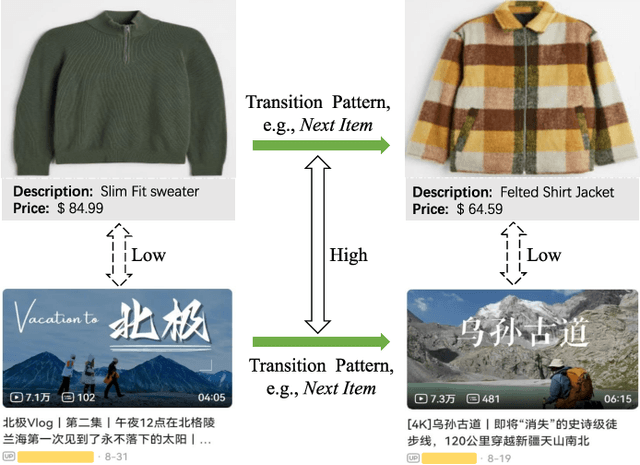
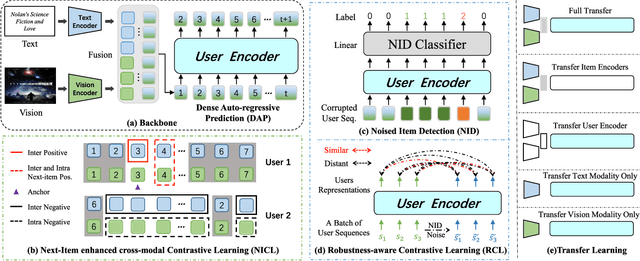
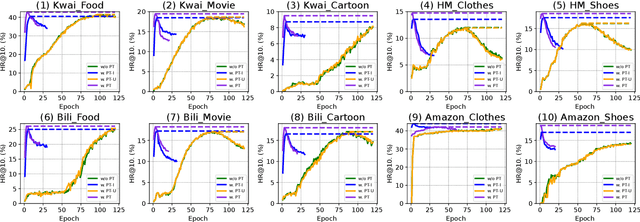
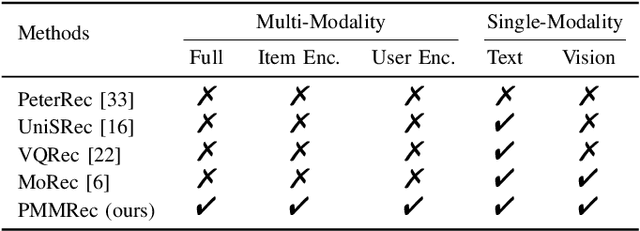
Abstract:ID-based Recommender Systems (RecSys), where each item is assigned a unique identifier and subsequently converted into an embedding vector, have dominated the designing of RecSys. Though prevalent, such ID-based paradigm is not suitable for developing transferable RecSys and is also susceptible to the cold-start issue. In this paper, we unleash the boundaries of the ID-based paradigm and propose a Pure Multi-Modality based Recommender system (PMMRec), which relies solely on the multi-modal contents of the items (e.g., texts and images) and learns transition patterns general enough to transfer across domains and platforms. Specifically, we design a plug-and-play framework architecture consisting of multi-modal item encoders, a fusion module, and a user encoder. To align the cross-modal item representations, we propose a novel next-item enhanced cross-modal contrastive learning objective, which is equipped with both inter- and intra-modality negative samples and explicitly incorporates the transition patterns of user behaviors into the item encoders. To ensure the robustness of user representations, we propose a novel noised item detection objective and a robustness-aware contrastive learning objective, which work together to denoise user sequences in a self-supervised manner. PMMRec is designed to be loosely coupled, so after being pre-trained on the source data, each component can be transferred alone, or in conjunction with other components, allowing PMMRec to achieve versatility under both multi-modality and single-modality transfer learning settings. Extensive experiments on 4 sources and 10 target datasets demonstrate that PMMRec surpasses the state-of-the-art recommenders in both recommendation performance and transferability. Our code and dataset is available at: https://github.com/ICDE24/PMMRec.
Ensemble Modeling with Contrastive Knowledge Distillation for Sequential Recommendation
May 04, 2023



Abstract:Sequential recommendation aims to capture users' dynamic interest and predicts the next item of users' preference. Most sequential recommendation methods use a deep neural network as sequence encoder to generate user and item representations. Existing works mainly center upon designing a stronger sequence encoder. However, few attempts have been made with training an ensemble of networks as sequence encoders, which is more powerful than a single network because an ensemble of parallel networks can yield diverse prediction results and hence better accuracy. In this paper, we present Ensemble Modeling with contrastive Knowledge Distillation for sequential recommendation (EMKD). Our framework adopts multiple parallel networks as an ensemble of sequence encoders and recommends items based on the output distributions of all these networks. To facilitate knowledge transfer between parallel networks, we propose a novel contrastive knowledge distillation approach, which performs knowledge transfer from the representation level via Intra-network Contrastive Learning (ICL) and Cross-network Contrastive Learning (CCL), as well as Knowledge Distillation (KD) from the logits level via minimizing the Kullback-Leibler divergence between the output distributions of the teacher network and the student network. To leverage contextual information, we train the primary masked item prediction task alongside the auxiliary attribute prediction task as a multi-task learning scheme. Extensive experiments on public benchmark datasets show that EMKD achieves a significant improvement compared with the state-of-the-art methods. Besides, we demonstrate that our ensemble method is a generalized approach that can also improve the performance of other sequential recommenders. Our code is available at this link: https://github.com/hw-du/EMKD.
Sequential Recommendation with Diffusion Models
Apr 10, 2023Abstract:Generative models, such as Variational Auto-Encoder (VAE) and Generative Adversarial Network (GAN), have been successfully applied in sequential recommendation. These methods require sampling from probability distributions and adopt auxiliary loss functions to optimize the model, which can capture the uncertainty of user behaviors and alleviate exposure bias. However, existing generative models still suffer from the posterior collapse problem or the model collapse problem, thus limiting their applications in sequential recommendation. To tackle the challenges mentioned above, we leverage a new paradigm of the generative models, i.e., diffusion models, and present sequential recommendation with diffusion models (DiffRec), which can avoid the issues of VAE- and GAN-based models and show better performance. While diffusion models are originally proposed to process continuous image data, we design an additional transition in the forward process together with a transition in the reverse process to enable the processing of the discrete recommendation data. We also design a different noising strategy that only noises the target item instead of the whole sequence, which is more suitable for sequential recommendation. Based on the modified diffusion process, we derive the objective function of our framework using a simplification technique and design a denoise sequential recommender to fulfill the objective function. As the lengthened diffusion steps substantially increase the time complexity, we propose an efficient training strategy and an efficient inference strategy to reduce training and inference cost and improve recommendation diversity. Extensive experiment results on three public benchmark datasets verify the effectiveness of our approach and show that DiffRec outperforms the state-of-the-art sequential recommendation models.
 Add to Chrome
Add to Chrome Add to Firefox
Add to Firefox Add to Edge
Add to Edge